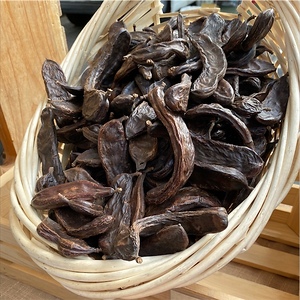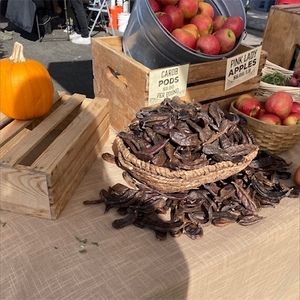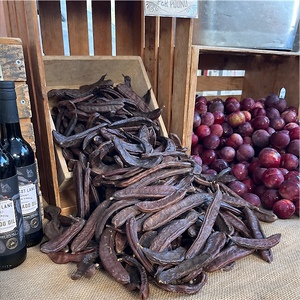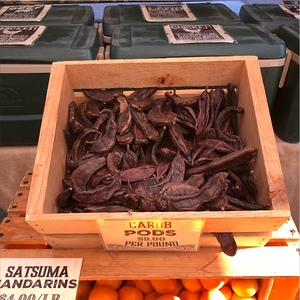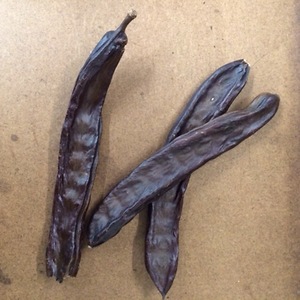

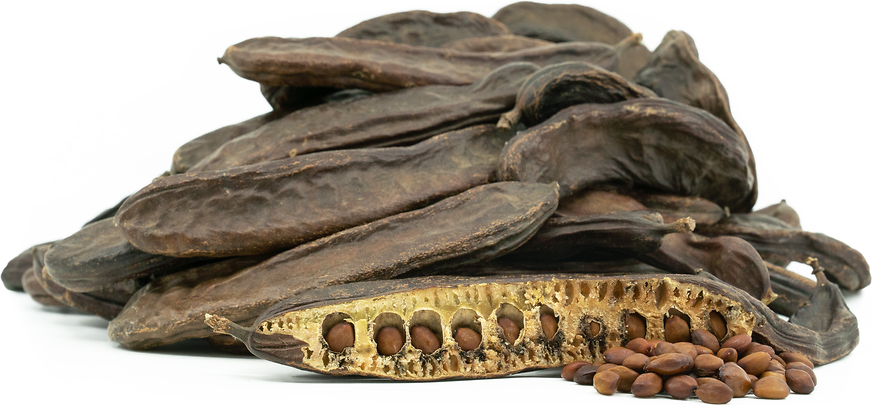
Carob
Estimated Inventory, 30 lbs : 0
Description/Taste
Carob is a long, flattened pod encasing small seeds. These pods average 10 to 30 centimeters in length and 1 to 4 centimeters in diameter and have a cylindrical shape with bluntly curved ends and a compressed appearance. When young, the pods are plump and green. As the pods mature, they become hard, creased, and wrinkled with a firm, leathery feel. The pods can be straight, curved, or slightly twisted and darken in color to a chocolate brown hue. Beneath the pod’s tough exterior, a layer of soft, sticky, and brown flesh, known as the mesocarp, envelops 5 to 15 small seeds. The seeds are small, pointed, and hard and can crack a tooth if bitten forcefully. Carob seeds range from 8 to 10 millimeters in length and are relatively uniform in size and shape. Carob pods can be eaten raw off the tree, and the fleshy mesocarp is the most consumed portion when consumed fresh. Carob has a naturally sweet, sugary, and honey-like taste with caramel and earthy nuances. The pods and seeds are also made into flour and syrups, which develop an added toasted flavor due to their processing.
Seasons/Availability
Carob is harvested in the late summer through winter, depending on the growing region. Once picked, the pods can be dried and stored for year-round availability.
Current Facts
Carob, botanically classified as Ceratonia siliqua, is an ancient species belonging to the Caesalpinioideae family, a subfamily of the legume family. The species is known for its edible fruit, which develops on broad, spreading trees reaching up to fifteen meters in height. The fruit is comprised of a large pod and seeds, which are typically used fresh, cooked into a syrup, or dried and ground into a powder. Carob trees begin bearing fruit around 6 to 7 years after planting, but the best-flavored pods for commercial cultivation develop when the tree has reached around 20 years of age. Throughout history, the story of Carob has fluctuated from a “poor man’s chocolate” to being labeled as “black gold.” The species is valued for its versatility, natural sweetness, and nutritional properties and is a widely cultivated crop throughout the Mediterranean. There are around fifty known varieties of Carob, and the fruits are labeled by many regional names, including St. John’s Bread and Locust Bean in English, Carrua in Italian, Alfarroba in Portuguese, Algarrobo in Spanish, and Keratōnia in Greece. Carob trees can live more than one hundred years, and the fruits are annually harvested in the fall by knocking pods from the trees with wooden sticks. Once gathered, the pods and seeds are dried and incorporated into various culinary and medicinal uses as a sweet ingredient.
Nutritional Value
Carob is a source of fiber to aid in digestion and potassium to replenish electrolytes and balance fluid levels within the body. The pods also provide vitamins A, B, C, D, and E to strengthen the immune system, maintain healthy organs, and guard the cells against damage caused by free radicals. Carob is known for its calcium content to support bones and teeth and contains amino acids and folate. Other nutrients include iron, magnesium, phosphorus, copper, manganese, and zinc. In the Mediterranean, Carob is incorporated into tinctures used in natural medicines to lessen cold symptoms. It is also made into beverages and consumed to help with respiratory issues.
Applications
Carob has a sweet, earthy, and rich taste suited for cooked preparations. The fleshy interior of the pods is edible raw and can be gently sucked on, being careful not to bite the harder exterior or the seeds. Younger green pods are also edible and have a softer consistency. Dried Carob pods can be softened and chewed like candy or baked in the oven and drizzled with honey. The most famous use of the dried pods is grinding them into a powder. This powder is often used as a chocolate substitute, giving dishes dark brown coloring. Carob powder is also used to bake bread, cookies, rusks, and brownies or incorporated into frosting and pudding. In the Mediterranean, Carob pods are popularly made into syrups and caramel. These syrups can be infused into salad dressings, drunk as a medicinal shot, or mixed into liqueurs and other beverages. Carob pods are also simmered into compotes and sauces or infused into ice cream and gelato. In Crete and Italy, Carob flour is notably mixed into handmade pasta dishes or added to cannoli shells for a darker appearance. The seeds are known for their high pectin content, and a gum-like substance is extracted as a thickener. Carob seeds are also roasted and used as a coffee substitute. Carob pods pair well with tahini, almonds, peanuts, figs, raspberries, and citrus. Fresh pods should be dried in the sun for extended use, where they will keep up to one year when stored in a cool, dry, and dark location.
Ethnic/Cultural Info
Carob seeds are the original measurement of weight once used for precious stones and grains. The practice of using the seeds arose from merchants in the Middle East. Carob seeds were believed to be uniform in size, averaging between 189 to 205 milligrams in weight, and were readily available to be sourced for business purposes. This uniformity and availability led the seeds to become a popular method of measuring for merchants and traders, especially when dealing with gemstones. The name Carob is derived from the Greek “Keration,” meaning “little or small horns.” The pods were given this name for their animal-horn-like appearance. Later in history, the Greek name for Carob inspired the creation of the Arabic word “qirat.” This name eventually became known as carat in English, a term still used in the modern day to measure gemstones. Later, in 1907, a standard weight for carat measurements was established, and though Carob seeds were no longer needed, their influence on the word carat remains. A carat now weighs 200 milligrams and is standard across jewelers, merchants, and businesses worldwide.
Geography/History
Carob is native to the Mediterranean and Middle East and has been growing wild since ancient times. For many centuries, the species was foraged from wild trees as a food source for animals. As it naturalized and spread through external causes, various civilizations adopted new uses for the fruits. Early traces of Carob pods and seeds were discovered in Egyptian tombs, and pectin from the seeds was found in some Egyptian mummification processes. Carob charcoal was later seen in archeological sites in Crete from the Late Minoan Period, spanning from 1560 to 1050 BCE, and during the Roman Empire, the species was selected for cultivation, further expanding its use and notoriety across the Mediterranean. Carob was documented by Theophrastus, an ancient Greek naturalist and successor of Aristotle, and Pliny the Elder, a Roman naturalist. Over time, wild Carob trees were selected and cultivated for larger pod sizes. Evidence of Carob pods throughout the Mediterranean continued to be uncovered, including in the storehouse ruins of Pompeii, indicating that the species was widely grown. Carob cultivation gradually increased to an important export crop around the 9th century CE, especially in Italy, and islands such as Crete and Cyprus also exported the pods as a source of income. Carob cultivation is a labor-intensive process, and farmers often lived beside their Carob trees until the harvest was complete. Mediterranean communities revolved around the harvest season, and the significance of the pods rose and fell throughout history, depending on the impact of other events. Carob pods were famously consumed during wars, especially during World War II, as a famine food and edible ingredient when other foods were scarce. Many Greek and Italian villages survived World War II by being able to gather Carob pods. After the war, the pods developed a reputation for being a disliked food. The pods often triggered memories of poverty and war-stricken times, leading many growers to abandon Carob cultivation in the Mediterranean. Spanish missionaries are credited with introducing Carob trees to the United States and South America, and in 1854, the United States Plant Patent Office purchased over 8,000 Carob trees and planted them throughout California, mainly in San Diego County. The species was initially successful in the United States and reached the height of its popularity in the late 20th century. Production in the Mediterranean was also re-established in the late 20th century and Carob trees were planted on farms, in city landscapes, and as a shade tree in home gardens. Today, Carob trees thrive in subtropical to warm, temperate climates and are a hardy species, surviving in a wide array of soil types. Carob pods are commercially cultivated throughout the Middle East and Mediterranean, mainly in Portugal, Greece, Cyprus, Italy, Morrocco, and Turkey. The species is also grown on more minor scales in Australia, the United States, Africa, and South America.
Recipe Ideas
Recipes that include Carob. One



